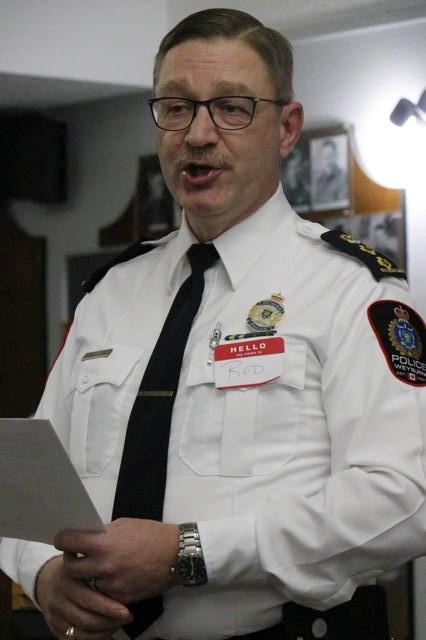The Weyburn Police Service has a long and colourful history, Rotary Club members heard in a presentation by Deputy Chief Rod Stafford at their luncheon meeting on Thursday.
The first municipal police force in Weyburn was formed in 1912, when the new town was in an economic boom, growing from a population of 2,200 in 1910 to 5,000 in 1912, the year before Weyburn officially became a city.
At the start, the force was comprised of chief constable Blaikie and three other constables, said Stafford, noting one of the tools they used was a spring-loaded stun gun that used lead balls, along with .38-calibre revolvers. They had all black uniforms with white shirts, and the officers mainly had foot patrols.
“As cars became available, one was accessible,” he noted, and the force operated until 1944 when it was disbanded due to the Second World War, and the RCMP took over policing of the city.
The Weyburn Police Service was then reorganized in 1957 under the leadership of Chief James McCardle, who had formerly served with the RCMP.
“I understand he was a most interesting individual to work for,” said Stafford, noting the force had eight members including the chief, expanding to 10 members in 1958.
One of the major advances at that time was the development of the Canadian Police Information Centre, or CPIC, which is still in operation today, connecting all police agencies across Canada.
“We were able to check people for warrants, and we had access to criminal records, so it really was in effect the first computer system of police forces,” said Stafford, recalling when he first started working for the police, he had to enter everything in DOS coding.
He also noted that Chief McCardle locked the access to CPIC in his office at night, “because he didn’t want people playing with it.”
Ted Williams then took over as the police chief, and in the 1970s, a new Police Act came into effect for the province, and the Saskatchewan Police College was established in 1974.
“The police college was a one-stop shop for municipal police forces in Saskatchewan, and is the main supplier of training for police and RCMP in the province today,” said Stafford, noting it is a very highly-regarded college across Canada.
Up until then too, the police department had a total of three Colt .38-calibre handguns, which were shared around, but then every officer was issued their own firearm, and the force moved “to a more professional police service,” said Stafford, noting that during this time also the first forensic identification department was established. Bill Millar was the first qualified officer to work in that department, he noted.
He told of one instance when Millar was out at a scene and took all the photos, only to find out when he got back to the police station that he forgot to put a film in the camera.
Stafford noted there were four murders in Weyburn from the 1950s to the 70s.
Gordon Dynna was sworn in as the chief in 1985, as the last original member from the department’s formation in 1957. “I don’t think any other department can claim that,” said Stafford, adding that under Dynna, Weyburn police had their first computerized system.
Under this chief Weyburn also saw their first sworn female constable, he noted. “To this day we actively try to have four female officers. We’re down to three right now. It’s a tough career for females, but it’s not because it’s a male-dominated occupation, but because of the shift work and family commitments. Due to the nature of the work, it takes a special kind of female to make it work.”
The police department had been located in the basement of the old City Hall until 1986, when they moved into their own building on Fourth Street.
Millar was the chief from 1993 until his retirement in 2003, and Weyburn’s fifth murder occurred during this time.
A major shift in terms of equipment occurred when the force moved away from the .38-calibre handgun to the semi-automatic .40-calibre Smith-and-Wesson Glock. As Stafford noted, this gun is extremely light, but the three clips with 46 rounds are not, and with the taser, flashlight and baton, the police belt weighs about 22 pounds as part of today’s police uniform.
Asked if a city police officer has ever fired a weapon at someone, Stafford replied, “We’ve never shot anybody, but we have shot at people in vehicles.”
The police also have been carrying shotguns in their cars, and after the recent events in Moncton, N.B., where RCMP officers were shot, police officers have now been moving to the carbine rifle.
“We have four of those. They’re not a sniper gun, they’re to be used if you have something like a hostage incident or something like that,” said Stafford.
Rod Horsman took over as the chief in 2003, who served until he retired in 2009, then Howard Georgeson was hired as the chief for two years. He was the first outside officer to be hired for this position, and the current chief, Marlo Pritchard, was the second, as he had previously served with the Regina Police Service before coming to Weyburn.
Under these chiefs were such developments as the regional victim services program, run by Tara Busch, technical advancements in computer technology, and the establishment of the CTSS combined traffic services division. One position with traffic services has been funded by SGI as the city police combine their efforts with the RCMP to do traffic enforcement in the area.
Something new this year for Weyburn is the hiring of the force’s first community safety officer, who will help do bylaw enforcement and traffic enforcement, along with other police-related duties that don’t require a gun and badge. Also, said Stafford, the police force will grow to 21 members for the first time this year, which will help strengthen their drug enforcement activities.



